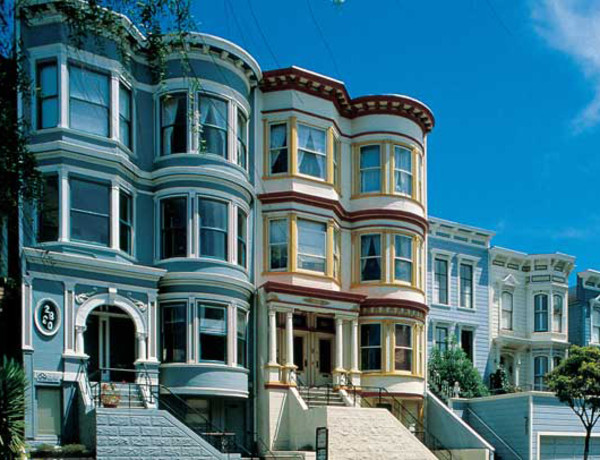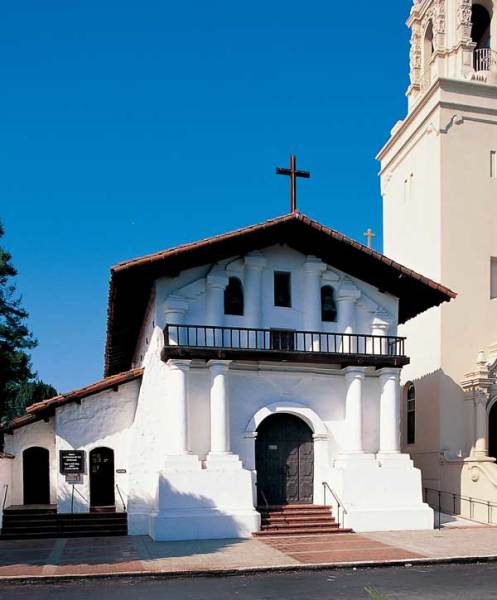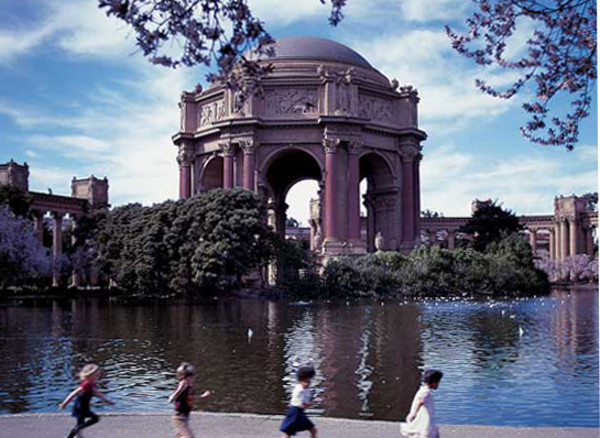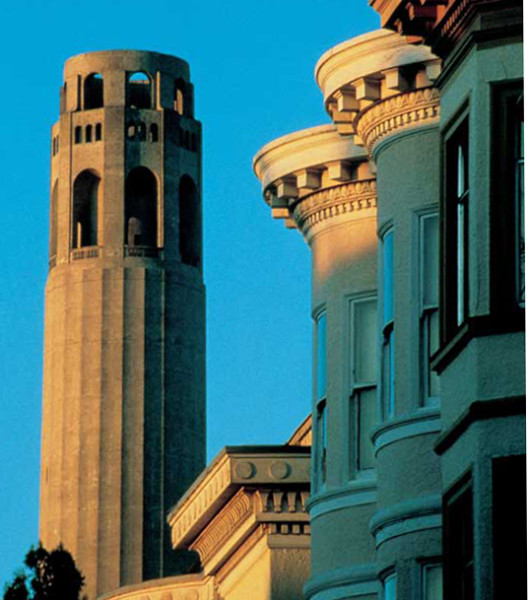
Many of San Francisco’s famous Victorians are Italianate-style row houses built between 1850 and 1875. (Photos: Courtesy of San Francisco Convention & Visitor’s Bureau)
You must see Fisherman’s Wharf and Chinatown, of course, and ride on a cable car. Alcatraz, the infamous island prison, is a visit that will haunt you (and a must if you care about concrete conservation). The Mission District around the historic church retains its old Hispanic flavor. The world-class museums are easy to find on any website that covers San Francisco arts or tourism. Other recommendations for old-house people follow.
The Gold Rush city (earlier called Yerba Buena) grew up in the Kearney Street-fronting part of Chinatown. Stockton Street was the first prestigious residential address, but fires sent the elite to Rincon Hill, south of Market Street. Little remains of those early neighborhoods, but the Mission Dolores, founded in 1776, stands intact with 4′-thick adobe walls, rawhide-lashed redwood timbers, and primitive ceiling paintings.
In chic Jackson Square, a fragment of the early boom years remains visible as faded lettering on a brick wall. “Hoating’s Whiskey” survived the earthquake and fire of 1906, leading to this taunt: “If, as some say, God spanked the town for being over-frisky, why did He burn the churches down, and yet save Hoating’s Whiskey?”

Located next to the Basilica, historic Mission Dolores is the oldest building standing in San Francisco.
The gold rush that jump-started the city petered out by 1854, but it expanded even faster during the following decades. Nevada’s Comstock Lode was controlled from here, drawing armies of bankers and businessmen to service first gold and then silver miners. The 1886 Haas–Lilienthal House, open to the public at 2007 Franklin Street, was built by one of the many merchants who prospered. The ca. 1861 Octagon House at 2645 Gough Street, in an area known as Cow Hollow, is a house museum (limited public hours) and home to the Society of the Colonial Dames.
Chinatown and North Beach became San Francisco’s first slums when the wealthy moved atop Nob Hill. Later, Van Ness Avenue was laid out as a broad, European-style boulevard for the most lavish mansions of the 1870s and ’80s. When they were destroyed in 1906, the city’s elite climbed another hill to Pacific Heights. North Beach today is home to City Lights, the bookstore made famous by beat poets Kerouac, Ginsberg, and Ferlinghetti. Visitors flock to Chinatown, and Van Ness Avenue hosts car dealerships, including the former Packard showroom designed by Bernard Maybeck. Pacific Heights is still genteel and lovely, with heady views of the city and the Golden Gate Bridge from leafy streets.

Landmarks include the Palace of Fine Arts, once part of the 1915 Panama-Pacific Exhibition.
For view-centric, architecture-oriented walkers, San Francisco is Mecca. Alamo Square provides a feast of Victorian houses; this is where they were first called “Painted Ladies.” For superb Art Deco buildings, stroll the Marina District. One block uphill from the Summer of Love tourist enclave of Haight–Ashbury, exquisite early 20th-century houses crowd tiny, steep hillside lots in Ashbury Heights. Walk toward the setting sun in Outer Richmond to gaze down at the Cliff House, a restaurant (in various iterations) perched on Point Lobos since 1863. Or watch the surfers from Sutro Heights Park. No visit to San Francisco is complete without a visit to Coit Tower atop Telegraph Hill, where dizzying views of the city vie with 1930s WPA murals for your attention.

Coit Tower (1933) sits atop Telegraph Hill.
In this city, you’ll never want for places to stroll; San Francisco dedicates more than 17 percent of its 47 square miles to parks and open space. Golden Gate Park, which stretches for three miles on the city’s western edge, has not a single “keep off the grass” sign. The Conservatory of Flowers is the oldest surviving glass and wood greenhouse in the U.S. Reflected in the waters of Lloyd Lake, also in Golden Gate Park, is a pair of marble Corinthian columns, which came from the portico of the Nob Hill home of A.N. Towne. Sentimentally known as Portals of the Past, this is San Francisco’s memorial to the terrible events of 1906.







